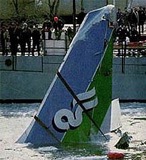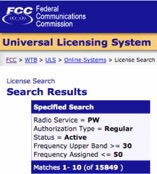public safety interoperability
The 700 MHz LTE Public Safety Plan: Some Concerns
02 06, 12 17:46 Filed in: spectrum policy | Public safety interoperability
I was at a conference recently where several knowledgable speakers dealt with the new public safety LTE system that Congress has mandated in Middle  Class Tax Relief and Job Creation Act of 2012 (P.L. 112-96) for the 700 MHz D block. Now public safety has not been a recurring topic here except for reminding readers that 30 years after the Air Florida crash highlighted the problem, we still have no nationwide interoperable public safety network.
Class Tax Relief and Job Creation Act of 2012 (P.L. 112-96) for the 700 MHz D block. Now public safety has not been a recurring topic here except for reminding readers that 30 years after the Air Florida crash highlighted the problem, we still have no nationwide interoperable public safety network.
For all its flaws, the European nations now have TETRA as their public safety network core. But the previous Motorola so thoroughly orchestrated the dissing of TETRA in favor of their preferred P25 in order to maintain market hegemony , that the US ended up with neither system. (At one point Motorola - not really the same company that exists today with that name - even tried to use its ownership on a patent used in TETRA to prevent any use of TETRA in USA. The ongoing Docket 11-69 deals with the issue of any future use of this technology in the US, not just public safety.)
Two issues dealing with 700 MHz LTE for public safety don’t get much discussion, so I will review them here:
1) 700 MHz This band is comparable to one of the frequencies used for cellular telephony since the 1980s. Many of us think of cellular service as ubiquitous, but it really isn’t in terms of the land mass of the US. The map at right is the coverage area of VerizonWireless and there are certainly coverage gaps in rural areas, specially those with rugged terrain. 700 MHz has slightly better propagation than the 800 MHz cellular band, but that will not solve this problem. It is not clear if it is economically practical to cover the US with 700 MHz coverage even if the cellular industry shared infrastructure with the new public safety network. Public safety officers lives depend on ubiquitous communications. Statewide public safety agencies, as well has local and regional agencies in rugged terrain, often use the 30-50 MHz band what has much greater range than higher bands although suffers from reliability problems due to quirky propagation phenomenon and also attracts little 8th Floor interest. A ULS search reveals 15,849 current (nonfederal) public safety licenses in this long range band. (Note that Spectrum Dashboard does not cover this low policy interest band - so we can’t give you any maps.)
 Note the Maryland State Police car shown at right. The antenna on the left side is almost certainly a 30-50 MHz antenna (probably license call sign KA2097) while the one on the trunk is a somewhat higher band, probably 150-170 MHz. Maryland is not a huge state. It has mountainous areas, but not as rugged terrain as some other states. Yet the Maryland State Police still depend on the unexotic “VHF low band” for life saving connectivity for their officers.
Note the Maryland State Police car shown at right. The antenna on the left side is almost certainly a 30-50 MHz antenna (probably license call sign KA2097) while the one on the trunk is a somewhat higher band, probably 150-170 MHz. Maryland is not a huge state. It has mountainous areas, but not as rugged terrain as some other states. Yet the Maryland State Police still depend on the unexotic “VHF low band” for life saving connectivity for their officers.
Now the nationwide public safety system could supplement the 700 MHz LTE systems with a more limited capability satellite (MSS) systems that provides connectivity where 700 MHz isn’t available. For example, the recently announced DeLorme inReach device uses the Iridium network and shows that limited emergency capability in isolated areas is available now at modest cost. But I have not seen any discussion about supplementing 700 MHz coverage with alternative media, such as MSS, for public safety agencies that will never have ubiquitous 700 MHz coverage in their territory. So how will the 15,849 present 30-50 MHz public safety licensees transition to the new 700 MHz system?
2) Voice over LTE Voice is an integral part of public safety communications now and in the foreseeable future. While using voice on an LTE system appears technical possible, it is not an operational reality. Last month, NetworkWorld quoted Verizon Vice President of Network Hans Leutenegger as saying that VZW “won't be deploying any voice over LTE (VoLTE) services on its network until late next year at the very earliest.” Public safety networks need not only voice, but voice with special features such as priorities, preemption, and network control by the commanders of first responders. These features are not operational as yet and it is not clear if the resources programmed for their development and testing are really adequate for the task - given the high reliability we owe our public safety officers.
More than a decade ago, the public safety community was greatly indebted to the old Motorola who invented this technology and shepherded it introduction into the public safety. Groups like APCO in the past showed their appreciation by allowing Motorola to manipulate their spectrum policy positions before FCC and they consistently opposed technical evolutions much more modest than which is involved here. Indeed, the fact that we are only now finishing the 20 year narrowband transition shows the effectiveness of this Motorola “partnership” with public safety that slowed technical progress while maintaining Motorola’s market share. The present Motorola Solutions no longer has the control of the old Motorola and others entities are trying to manipulate the public safety community for their own gains.
The fact that the public safety community generally seems happy with the present plan may indicate that the new manipulators have successfully filled the power vacuum left when Motorola was restructured. Hopefully the public safety community will become more cynical about being manipulated in the corporate interests of others and they will aggressively make sure their own interests are pursued in the development of the national wide interoperable system that is so critically needed.

For all its flaws, the European nations now have TETRA as their public safety network core. But the previous Motorola so thoroughly orchestrated the dissing of TETRA in favor of their preferred P25 in order to maintain market hegemony , that the US ended up with neither system. (At one point Motorola - not really the same company that exists today with that name - even tried to use its ownership on a patent used in TETRA to prevent any use of TETRA in USA. The ongoing Docket 11-69 deals with the issue of any future use of this technology in the US, not just public safety.)
Two issues dealing with 700 MHz LTE for public safety don’t get much discussion, so I will review them here:
1) 700 MHz This band is comparable to one of the frequencies used for cellular telephony since the 1980s. Many of us think of cellular service as ubiquitous, but it really isn’t in terms of the land mass of the US. The map at right is the coverage area of VerizonWireless and there are certainly coverage gaps in rural areas, specially those with rugged terrain. 700 MHz has slightly better propagation than the 800 MHz cellular band, but that will not solve this problem. It is not clear if it is economically practical to cover the US with 700 MHz coverage even if the cellular industry shared infrastructure with the new public safety network. Public safety officers lives depend on ubiquitous communications. Statewide public safety agencies, as well has local and regional agencies in rugged terrain, often use the 30-50 MHz band what has much greater range than higher bands although suffers from reliability problems due to quirky propagation phenomenon and also attracts little 8th Floor interest. A ULS search reveals 15,849 current (nonfederal) public safety licenses in this long range band. (Note that Spectrum Dashboard does not cover this low policy interest band - so we can’t give you any maps.)

Now the nationwide public safety system could supplement the 700 MHz LTE systems with a more limited capability satellite (MSS) systems that provides connectivity where 700 MHz isn’t available. For example, the recently announced DeLorme inReach device uses the Iridium network and shows that limited emergency capability in isolated areas is available now at modest cost. But I have not seen any discussion about supplementing 700 MHz coverage with alternative media, such as MSS, for public safety agencies that will never have ubiquitous 700 MHz coverage in their territory. So how will the 15,849 present 30-50 MHz public safety licensees transition to the new 700 MHz system?
2) Voice over LTE Voice is an integral part of public safety communications now and in the foreseeable future. While using voice on an LTE system appears technical possible, it is not an operational reality. Last month, NetworkWorld quoted Verizon Vice President of Network Hans Leutenegger as saying that VZW “won't be deploying any voice over LTE (VoLTE) services on its network until late next year at the very earliest.” Public safety networks need not only voice, but voice with special features such as priorities, preemption, and network control by the commanders of first responders. These features are not operational as yet and it is not clear if the resources programmed for their development and testing are really adequate for the task - given the high reliability we owe our public safety officers.
More than a decade ago, the public safety community was greatly indebted to the old Motorola who invented this technology and shepherded it introduction into the public safety. Groups like APCO in the past showed their appreciation by allowing Motorola to manipulate their spectrum policy positions before FCC and they consistently opposed technical evolutions much more modest than which is involved here. Indeed, the fact that we are only now finishing the 20 year narrowband transition shows the effectiveness of this Motorola “partnership” with public safety that slowed technical progress while maintaining Motorola’s market share. The present Motorola Solutions no longer has the control of the old Motorola and others entities are trying to manipulate the public safety community for their own gains.
The fact that the public safety community generally seems happy with the present plan may indicate that the new manipulators have successfully filled the power vacuum left when Motorola was restructured. Hopefully the public safety community will become more cynical about being manipulated in the corporate interests of others and they will aggressively make sure their own interests are pursued in the development of the national wide interoperable system that is so critically needed.
Comments





![Validate my RSS feed [Valid RSS]](valid-rss-rogers.png)

